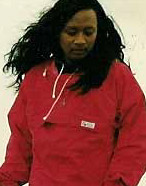 |
||
|---|---|---|
| CP Foundation | About CP Biennale | 2003 | 2005 | Contact Us | >||
           
|
||
|
Agung Suryanto has also been diligently "stealing" art icons and is certainly aware of what he has been doing. To achieve that, he merges the two classifications into one concept and theme, and at the same time place the "stolen" icons in new spatial concepts. As a painter with a background in the architecture, Agung believes that art works can become alive and deeply meaningful when placed in the "appropriate" place--both in the actual physical sense and the connotative, non-physical sense. It is this belief that forms the base of all Agung Tato's works, whether they are paintings, sculptures, or installation projects. The painting Dialog Antar Raden Saleh (Dialogues among Raden Salehs, 2003). Here Agung appears as a talented "thief". He plays around with the icon of Raden Saleh himself and also with the image in Raden Saleh's paintings--which have been canonized as the master piece of Indonesian art. The classical value becomes fluid. At the upper row, Raden Saleh is portrayed being in an autonomous space; the subject exists in the atmosphere or the aura of his era. One, however, can see a parody here, with the subject, i.e. Raden Saleh, is being threatened by his own works. In other words, Raden Saleh becomes a parody for himself. Meanwhile at the lower row, Raden Saleh is situated in a totally different and contradictory space. He is being confronted with contemporary icons that represent the consumptive habits, the industry, and market commodities. It seems that there is a merging of the masterpiece and the popular culture, the high art and the low art, the auratic and the post-auratic art. Hierarchy, therefore, has become obsolete. In this particular painting, Agung's architectural background directs him--whether he realizes this or not--to take advantage of the techniques of drawing. This method depends on shading patterns, precise forms, calculated compositions, and three-dimensional impressions. Almost everything is done here by relying on his manual skills. When many artists tend to take the benefits of technology in their creative processes, Agung chooses exactly to trust his authentic skills. Djuli Jati Prambudi Born on May 24, 1970 in Surabaya. SELECTED SOLO EXHIBITIONS SELECTED GROUP EXHIBITIONS |
||
|
CP Foundation | About CP Biennale | 2003 | 2005 | Contact Us
Jl. Suryopranoto 67A, Jakarta 10160, Indonesia. ph. +62.21.3448126, 3853206 | fax. +62.21.3853203, 3853208 info@cp-foundation.org |
||
 "Stealing" can be a common and normal thing to do. In the world of art, "stealing" intentionally and clearly icons from the works of Masterpiece has become a new modus operandi for the creative processes of some artists. In the contemporary art, the new method bear the label: appropriation. Such practice is highly possible. New understandings in the contemporary world, supported by the findings and development in the digital technology; the over-abundance of printed and electronic media; novel thoughts on deconstruction, intertextuality, simulation, hyper-reality, and the death of the author have all given rise to such "stealing practice". Nowadays, art no longer exists in the auratic realm (as an autonomous subject), but has rather shifted into the post-auratic realm as an open and interconnected fluid subject. By taking advantage of such issues, artists, therefore, are now in a euphoric condition with an infinitely vast creative domain that is full of surprises.
"Stealing" can be a common and normal thing to do. In the world of art, "stealing" intentionally and clearly icons from the works of Masterpiece has become a new modus operandi for the creative processes of some artists. In the contemporary art, the new method bear the label: appropriation. Such practice is highly possible. New understandings in the contemporary world, supported by the findings and development in the digital technology; the over-abundance of printed and electronic media; novel thoughts on deconstruction, intertextuality, simulation, hyper-reality, and the death of the author have all given rise to such "stealing practice". Nowadays, art no longer exists in the auratic realm (as an autonomous subject), but has rather shifted into the post-auratic realm as an open and interconnected fluid subject. By taking advantage of such issues, artists, therefore, are now in a euphoric condition with an infinitely vast creative domain that is full of surprises.